口译UNIT 5 第五单元教案
- 格式:doc
- 大小:74.00 KB
- 文档页数:6

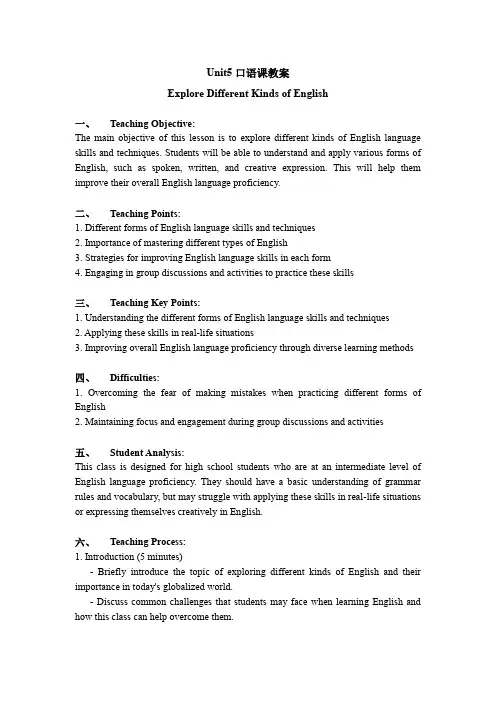
Unit5口语课教案Explore Different Kinds of English一、Teaching Objective:The main objective of this lesson is to explore different kinds of English language skills and techniques. Students will be able to understand and apply various forms of English, such as spoken, written, and creative expression. This will help them improve their overall English language proficiency.二、Teaching Points:1. Different forms of English language skills and techniques2. Importance of mastering different types of English3. Strategies for improving English language skills in each form4. Engaging in group discussions and activities to practice these skills三、Teaching Key Points:1. Understanding the different forms of English language skills and techniques2. Applying these skills in real-life situations3. Improving overall English language proficiency through diverse learning methods四、Difficulties:1. Overcoming the fear of making mistakes when practicing different forms of English2. Maintaining focus and engagement during group discussions and activities五、Student Analysis:This class is designed for high school students who are at an intermediate level of English language proficiency. They should have a basic understanding of grammar rules and vocabulary, but may struggle with applying these skills in real-life situations or expressing themselves creatively in English.六、Teaching Process:1. Introduction (5 minutes)-Briefly introduce the topic of exploring different kinds of English and their importance in today's globalized world.- Discuss common challenges that students may face when learning English and how this class can help overcome them.2. Formative Assessment (10 minutes)-Have students work in pairs to discuss their favorite ways to practice English (e.g., reading, writing, listening, speaking) and why they enjoy these activities.-Encourage students to share examples of how they have used English in their daily lives.3. Learning Objectives (15 minutes)-Introduce the different forms of English language skills and techniques (e.g., spoken, written, creative expression).-Discuss the benefits of mastering each form and how it can improve overall English language proficiency.- Provide examples of each form and discuss strategies for improving each skill.4. Application (20 minutes)-Break students into small groups and assign each group a specific form of English language skill or technique to explore (e.g., poetry writing, storytelling, debate).- Have students engage in group discussions and activities related to their assigned skill, using a variety of resources (e.g., books, articles, videos).- Encourage students to share their findings with the class and provide feedback on each other's work.5. Closing (5 minutes)- Review the key points covered in the lesson and emphasize the importance of practicing different forms of English in order to improve overall proficiency.- Ask students to reflect on what they learned in this lesson and what they plan to do differently moving forward to improve their English language skills.七、Homework:1. Write a reflection paper on the different forms of English language skills and techniques covered in the lesson. Discuss how you can apply these skills in your own life to improve your overall English language proficiency.2. Practice a new form of English language skill or technique outside of school by setting aside time each day to engage in the activity (e.g., reading a book in English, watching a movie without subtitles, joining an online forum to practice writing).3. Share your progress with your teacher or classmates by presenting your reflection paper or sharing your experiences practicing a new form of English language skill or technique.。
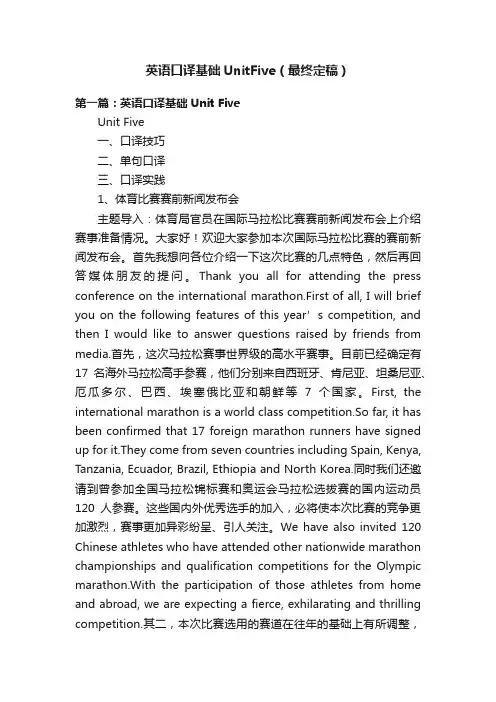
英语口译基础UnitFive(最终定稿)第一篇:英语口译基础Unit FiveUnit Five一、口译技巧二、单句口译三、口译实践1、体育比赛赛前新闻发布会主题导入:体育局官员在国际马拉松比赛赛前新闻发布会上介绍赛事准备情况。
大家好!欢迎大家参加本次国际马拉松比赛的赛前新闻发布会。
首先我想向各位介绍一下这次比赛的几点特色,然后再回答媒体朋友的提问。
Thank you all for attending the press conference on the international marathon.First of all, I will brief you on the following features of this year’s competition, and then I would like to answer questions raised by friends from media.首先,这次马拉松赛事世界级的高水平赛事。
目前已经确定有17名海外马拉松高手参赛,他们分别来自西班牙、肯尼亚、坦桑尼亚、厄瓜多尔、巴西、埃塞俄比亚和朝鲜等7个国家。
First, the international marathon is a world class competition.So far, it has been confirmed that 17 foreign marathon runners have signed up for it.They come from seven countries including Spain, Kenya, Tanzania, Ecuador, Brazil, Ethiopia and North Korea.同时我们还邀请到曾参加全国马拉松锦标赛和奥运会马拉松选拔赛的国内运动员120人参赛。
这些国内外优秀选手的加入,必将使本次比赛的竞争更加激烈,赛事更加异彩纷呈、引人关注。


Unit5全单元教案Unit 5 What are the shirts made of?教案Period 1 Section A 1 (1a-2d)一、教学目标:1. 语言知识目标:1) 能掌握以下单词:chopsticks, coin, fork, blouse, silver, glass, cotton, steel, grass, leaf, produce, widely, be known for, process, pack能掌握以下句型:①—This ring looks nice. Is it made of silver? —Yes, and it was made in Thailand.②What is it made of/from?③China is famous for tea, right?④Where is tea produced in China?2) 能够用英语描述及询问物品的制作材料,准确理解被动语态的用法及句子结构。
2. 情感态度价值观目标:了解一些日常用品的制成材料,增加生活常识,养成良好的生活习惯;了解一些地方知名产品或传统艺术品的制作过程以及制作材料,培养学生的民族自豪感及爱国主义精神。
二、教学重难点1. 教学重点:1) 掌握本课时中出现的生词2) 能够用英语描述及询问物品的制作材料3)准确理解被动语态的用法及句子结构。
2. 教学难点:理解被动语态的用法及句子结构。
三、教学过程Step 1 Lead in 让学生们了解这个中国传统发明的情况。
T:Who invented paper first?S1:Can Lun invented it in Han dynasty.T:What was paper made of then?S2:It was mainly made of bamboo.T:was it easy for people to make paper then?S1:No, it was very difficult then.T:What is paper made of now?S3:It’s mainly made of wood, ba mboo, and cotton.…Step 2 Presentation Present the sentence structure, using the pictures on the big screen:—What’s the golden medal made of?—It’s made of gold.—Is this table made of wood?—No, it isn’t.It’s made of glass.—Is Butter made from meat?—No. It’s made from cream?让学生们学习掌握be made of/from句型的用法,及be made of与be made from的区别。
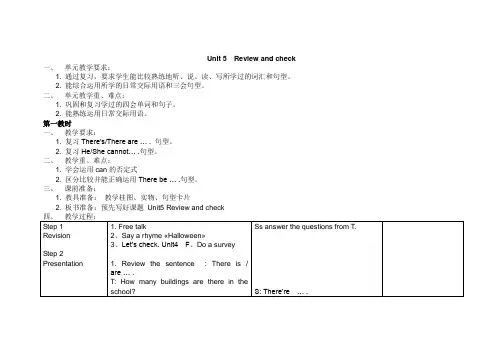
Unit 5 Review and check一、单元教学要求:1. 通过复习,要求学生能比较熟练地听、说、读、写所学过的词汇和句型。
2. 能综合运用所学的日常交际用语和三会句型。
二、单元教学重、难点:1. 巩固和复习学过的四会单词和句子。
2. 能熟练运用日常交际用语。
第一教时一、教学要求:1. 复习There’s/There are … . 句型。
2. 复习He/She cannot… .句型。
二、教学重、难点:1. 学会运用can的否定式2. 区分比较并能正确运用There be … .句型。
三、课前准备:1. 教具准备:教学挂图、实物、句型卡片2. 板书准备:预先写好课题Unit5 Review and checkThere is not a … .There are not any … .He /She cannot … .第二教时一、教学要求:1. 复习Where’re … ?They’re in / on / behind / between / beside … .2. 复习巩固四会单词、句子和方位词的正确用法。
二、教学重、难点:1. 熟练运用介词短语以及相关句型2. 区分Where is /are … ?以及相应的回答It’s … . They’re … .三、课前准备:1. 教具准备:教学挂图、词组卡片、文具用品、盒子等实物2. 板书准备:Unit 5 Review and checkWhere is the fish?It’s第三教时一、教学要求巩固复习Do you like … ?Yes, I do. / No, I don’t.What do you like?I like … .Can you … ?二、教学重难点1.区别比较句型Do you like … ?What do you like? 及相应的回答。
2.物品单复数的比较运用。
三、课前准备1.教具准备:教学挂图、句型卡片、动物面具等2.板书准备:预先写好Unit 5 Review and checkDo you lik e … ?Yes, I do. / No, I don’t.What do you like ?I like … .Can you … ?Yes, I can. / No, I can’t.第四教时一、教学要求:巩固和复习句型:Can you see … in the picture?Yes, I can.How many …are there?There’s / There are … .Where is it /are they?It’s / They’re … .二、教学重、难点:熟练运用以上句型三、课前准备:1. 教具准备:教学挂图、句型卡片2. 板书准备:预先写好Unit 5 Review and check.Unit 5 Review and checkCan you see … in the picture ?Yes, I can. / No, I can’t.How many … are there ?There’s /There are … .Where is it ?/ Where are they ?It’s … . / They’re… .第五课时单元目标检测第六课时分析讲评单元目标检测。
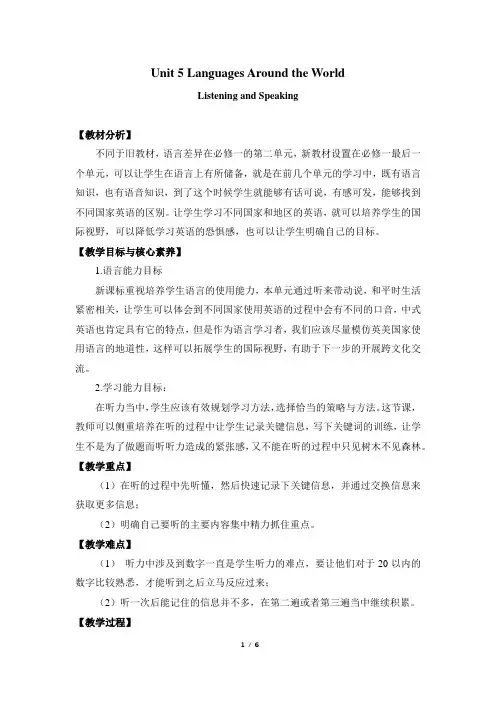
Unit 5 Languages Around the WorldListening and Speaking【教材分析】不同于旧教材,语言差异在必修一的第二单元,新教材设置在必修一最后一个单元,可以让学生在语言上有所储备,就是在前几个单元的学习中,既有语言知识,也有语音知识,到了这个时候学生就能够有话可说,有感可发,能够找到不同国家英语的区别。
让学生学习不同国家和地区的英语,就可以培养学生的国际视野,可以降低学习英语的恐惧感,也可以让学生明确自己的目标。
【教学目标与核心素养】1.语言能力目标新课标重视培养学生语言的使用能力,本单元通过听来带动说,和平时生活紧密相关,让学生可以体会到不同国家使用英语的过程中会有不同的口音,中式英语也肯定具有它的特点,但是作为语言学习者,我们应该尽量模仿英美国家使用语言的地道性,这样可以拓展学生的国际视野,有助于下一步的开展跨文化交流。
2.学习能力目标:在听力当中,学生应该有效规划学习方法,选择恰当的策略与方法。
这节课,教师可以侧重培养在听的过程中让学生记录关键信息,写下关键词的训练,让学生不是为了做题而听听力造成的紧张感,又不能在听的过程中只见树木不见森林。
【教学重点】(1)在听的过程中先听懂,然后快速记录下关键信息,并通过交换信息来获取更多信息;(2)明确自己要听的主要内容集中精力抓住重点。
【教学难点】(1)听力中涉及到数字一直是学生听力的难点,要让他们对于20以内的数字比较熟悉,才能听到之后立马反应过来;(2)听一次后能记住的信息并不多,在第二遍或者第三遍当中继续积累。
【教学过程】Unit 5 Languages Around the WorldListening and Speaking 导学案【学习目标】1. 掌握适当的听力技巧及正确的口语表达方式;2. 在听力过程中,掌握适当技能帮助记忆,尤其是做笔记的有效使用。
【学习重难点】1.重点(1)在听的过程中先听懂,然后快速记录下关键信息,并通过交换信息来获取更多信息;(2)明确自己要听的主要内容集中精力抓住重点。
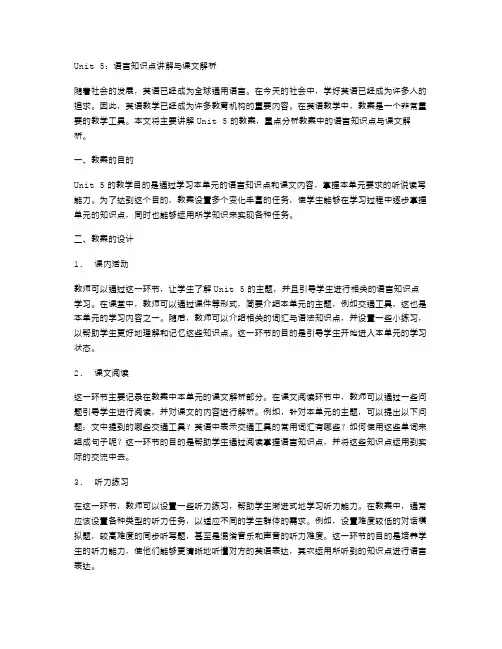
Unit 5:语言知识点讲解与课文解析随着社会的发展,英语已经成为全球通用语言。
在今天的社会中,学好英语已经成为许多人的追求。
因此,英语教学已经成为许多教育机构的重要内容。
在英语教学中,教案是一个非常重要的教学工具。
本文将主要讲解Unit 5的教案,重点分析教案中的语言知识点与课文解析。
一、教案的目的Unit 5的教学目的是通过学习本单元的语言知识点和课文内容,掌握本单元要求的听说读写能力。
为了达到这个目的,教案设置多个变化丰富的任务,使学生能够在学习过程中逐步掌握单元的知识点,同时也能够运用所学知识来实现各种任务。
二、教案的设计1.课内活动教师可以通过这一环节,让学生了解Unit 5的主题,并且引导学生进行相关的语言知识点学习。
在课堂中,教师可以通过课件等形式,简要介绍本单元的主题,例如交通工具,这也是本单元的学习内容之一。
随后,教师可以介绍相关的词汇与语法知识点,并设置一些小练习,以帮助学生更好地理解和记忆这些知识点。
这一环节的目的是引导学生开始进入本单元的学习状态。
2.课文阅读这一环节主要记录在教案中本单元的课文解析部分。
在课文阅读环节中,教师可以通过一些问题引导学生进行阅读,并对课文的内容进行解析。
例如,针对本单元的主题,可以提出以下问题:文中提到的哪些交通工具?英语中表示交通工具的常用词汇有哪些?如何使用这些单词来组成句子呢?这一环节的目的是帮助学生通过阅读掌握语言知识点,并将这些知识点运用到实际的交流中去。
3.听力练习在这一环节,教师可以设置一些听力练习,帮助学生渐进式地学习听力能力。
在教案中,通常应该设置各种类型的听力任务,以适应不同的学生群体的需求。
例如,设置难度较低的对话模拟题,较高难度的同步听写题,甚至是混淆音乐和声音的听力难度。
这一环节的目的是培养学生的听力能力,使他们能够更清晰地听懂对方的英语表达,其次运用所听到的知识点进行语言表达。
4.口语表达在这一环节,教师可以设置一些几人或多人的对话练习,通过通过轮流表达观点,逐步提高学生的口语表达能力。
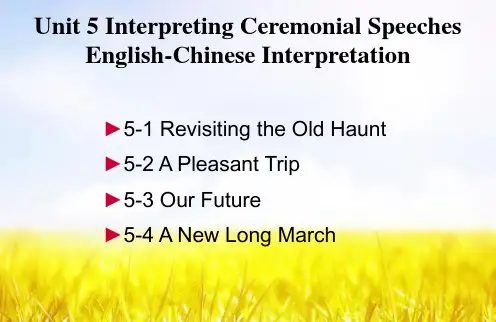
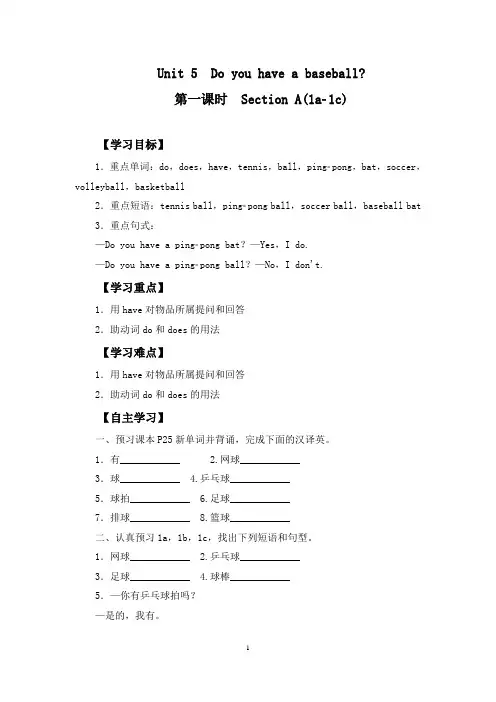
Unit 5 Do you have a baseball?第一课时Section A(1a1c)【学习目标】1.重点单词:do,does,have,tennis,ball,pingpong,bat,soccer,volleyball,basketball2.重点短语:tennis ball,pingpong ball,soccer ball,baseball bat 3.重点句式:—Do you have a pingpong bat?—Yes,I do.—Do you have a pingpong ball?—No,I don't.【学习重点】1.用have对物品所属提问和回答2.助动词do和does的用法【学习难点】1.用have对物品所属提问和回答2.助动词do和does的用法【自主学习】一、预习课本P25新单词并背诵,完成下面的汉译英。
1.有____________ 2.网球____________3.球____________ 4.乒乓球____________5.球拍____________ 6.足球____________7.排球____________ 8.篮球____________二、认真预习1a,1b,1c,找出下列短语和句型。
1.网球____________ 2.乒乓球____________3.足球____________ 4.球棒____________5.—你有乒乓球拍吗?—是的,我有。
6.—你有一个乒乓球吗?—不,我没有。
【课堂导学】Step 1情景导入(Show some pictures of different kinds of balls)T:Do you like sports?What kind of balls do you like?I like ball games.And I have many balls.Do you know their names?Today we will learn how to say the names of the balls in English.环节说明:由贴近学生日常生活的体育运动为切入点,引起学生的学习兴趣。
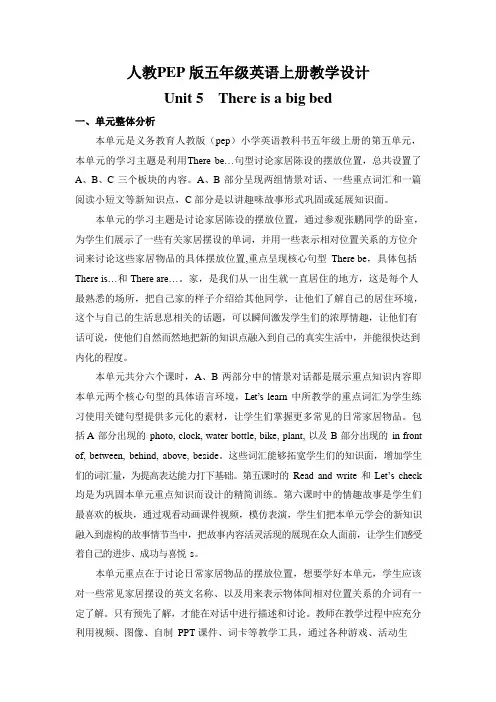
人教PEP 版五年级英语上册教学设计Unit 5 There is a big bed一、单元整体分析本单元是义务教育人教版(pep)小学英语教科书五年级上册的第五单元,本单元的学习主题是利用There be…句型讨论家居陈设的摆放位置,总共设置了A、B、C 三个板块的内容。
A、B 部分呈现两组情景对话、一些重点词汇和一篇阅读小短文等新知识点,C 部分是以讲趣味故事形式巩固或延展知识面。
本单元的学习主题是讨论家居陈设的摆放位置,通过参观张鹏同学的卧室,为学生们展示了一些有关家居摆设的单词,并用一些表示相对位置关系的方位介词来讨论这些家居物品的具体摆放位置,重点呈现核心句型There be,具体包括There is…和There are…。
家,是我们从一出生就一直居住的地方,这是每个人最熟悉的场所,把自己家的样子介绍给其他同学,让他们了解自己的居住环境,这个与自己的生活息息相关的话题,可以瞬间激发学生们的浓厚情趣,让他们有话可说,使他们自然而然地把新的知识点融入到自己的真实生活中,并能很快达到内化的程度。
本单元共分六个课时,A、B 两部分中的情景对话都是展示重点知识内容即本单元两个核心句型的具体语言环境,Let’s learn 中所教学的重点词汇为学生练习使用关键句型提供多元化的素材,让学生们掌握更多常见的日常家居物品。
包括A 部分出现的photo, clock, water bottle, bike, plant, 以及B 部分出现的in front of, between, behind, above, beside。
这些词汇能够拓宽学生们的知识面,增加学生们的词汇量,为提高表达能力打下基础。
第五课时的Read and write 和Let’s check 均是为巩固本单元重点知识而设计的精简训练。
第六课时中的情趣故事是学生们最喜欢的板块,通过观看动画课件视频,模仿表演,学生们把本单元学会的新知识融入到虚构的故事情节当中,把故事内容活灵活现的展现在众人面前,让学生们感受着自己的进步、成功与喜悦s。
UNIT 5 第五单元来源:口译-学院精品课程作者:Jay J YangSTENOGRAPHY (II)口译笔记技巧(二)Unit Objective (单元目标)After reading this unit you should☆ understand the structure of stenographic notes.☆ master the two major types of stenography.Warm-up (准备)1. Two students are requested to sit at the Interpreting Desk or Booth, acting as interpreters of the class. Their performance is evaluated and graded by instructor.2.One or Two students are asked to present a piece of news or a weather forecast of the week.Theory of Interpretation (口译理论)口译笔记的结构:纵向分页、横向分段、阶梯排列、条列记录。
口译笔记的符号:符号的利用与创新、古英语缩写法、常用缩写词。
Memoria Technica (记忆法)Listen to the following passage, “Dutch Treat”, and try to catch the key words and details, then retell them in your own words:Dutch TreatThe phrase “Dutch Treat” can sometimes pull you out of a group of four and had an expensive diner.Well, the waiter brings the check shortly after you have offered to pay for the diner. You look at the check and shocked at the total cost. Whew! Slowly you pick up the check, but the only other man in the group says: “Just a minute. Let me take it.”Off course, he does not mean it, and feels safe in making the offer because you have already agreed to pay the check.. You both struggle,weakly, to pick up the bill. You have a way out. You say, “Let’s go Dutch,” or “Dutch Treat”. And so you both find a way out of the hole you dug for yourselves.Going Dutch or Dutch treat, simply means that everybody pays for himself. Why Dutch? Your guess is as good as mine.As it is well known, the English and Dutch fought bitterly in the 1660s for control of the seas. At the time the English settled in the New World, their hatred for the Dutch was intense and it was shown in the times they said about them:One expression is a “Dutch Bargain, meaning a one-sided exchange –the Dutch giving too little and asking too much. The English used the name Dutch in many other unpleasant ways. “To talk Dutch” or “Double Dutch” means to talk nonsense.Stenography (口译笔记)Read the first part of Unit 5 of your Textbook, to understand the structure of stenography, its four types of organization and two types of noting.A.Read the First part, “Reading Prelude” of Uni t 5 of the textbook..B.Review the Signs and continue to study stenography (2): Big Wordsand Place–name Abbreviations.(1)Method of Abbreviation for Big WordsWord Suffix Short Hand Sample… tion n Composition Cmp… ism m Socialism S… a ble bl Immovable M… ing g Interesting Inter… cal cl Economical Eco… ianºTechnician Tech(2) Abbreviation for Country (place)-NamesAbbreviation Country Name AA AustraliaAF AfghanistanAR ArgentinaB BelguimBM MurmaBR BrazilCA CanadaCN ChinaCU CubaD Germany (Deutchland)DK DenmarkE (S)SpainF FranceHK Hong KongI ItalyIK IraqIN IndiaIR IranIRL IrelandJ JapanK Korea-K South KoreaK-North KoreaMA MalaysiaME MexicoNZ New ZealandPH The PhilippinesPK PakistanPL PolandRM RomaniaSGP SingaporeTH ThailandUS The United StatesUK The United Kingdom(Britain)VT Vietnam(3) Example:Ladies and Gentlemen, I regard it as a great honor to announce the opening of Shanghai Exhibition. There are over 10000 visitors every day, who came from US, Great Britain, South Kerea, Singapore, New Zealand, Japan, Canada, and other European countries.句序口译笔记理解(暗记)1 L、G、I 开 exhi SH//女先,我荣幸开展览馆上海210’ °d← USUK-KSGPNZJCaE □ //一万人天来自美国英国南韩新加坡新西兰日本加拿大欧洲国家C.Practice work on the second part, “Exercises” of Unit 5 of thetextbook..Cultural Salon or Seminar (文化沙龙或研讨会)In the last 20 minutes will be a cultural salon or seminar. Two or three students who have been asked to prepare a speech in advance on a given topic. Students will do the oral interpretation.Topic: SocietyHomework Assignments (课后作业)Work on Exercise 3 in Unit 4 of the Textbook: Information Industry: Engine of Economic GrowthTask 1: Listen to the article and then start interpreting at the end of each segment.Task 2: Use the signs of Stenography learnt in this class to take notes while reading the article.Reference (单元参考资料)仲伟合主编:《英语口译教程》(上下册),高等教育出版社,2005年版。
UNIT 5 第五单元来源:口译-学院精品课程作者:Jay J YangSTENOGRAPHY (II)口译笔记技巧(二)Unit Objective (单元目标)After reading this unit you should☆ understand the structure of stenographic notes.☆ master the two major types of stenography.Warm-up (准备)1. Two students are requested to sit at the Interpreting Desk or Booth, acting as interpreters of the class. Their performance is evaluated and graded by instructor.2.One or Two students are asked to present a piece of news or a weather forecast of the week.Theory of Interpretation (口译理论)口译笔记的结构:纵向分页、横向分段、阶梯排列、条列记录。
口译笔记的符号:符号的利用与创新、古英语缩写法、常用缩写词。
Memoria Technica (记忆法)Listen to the following passage, “Dutch Treat”, and try to catch the key words and details, then retell them in your own words:Dutch TreatThe phrase “Dutch Treat” can sometimes pull you out of a group of four and had an expensive diner.Well, the waiter brings the check shortly after you have offered to pay for the diner. You look at the check and shocked at the total cost. Whew! Slowly you pick up the check, but the only other man in the group says: “Just a minute. Let me take it.”Off course, he does not mean it, and feels safe in making the offer because you have already agreed to pay the check.. You both struggle,weakly, to pick up the bill. You have a way out. You say, “Let’s go Dutch,” or “Dutch Treat”. And so you both find a way out of the hole you dug for yourselves.Going Dutch or Dutch treat, simply means that everybody pays for himself. Why Dutch? Your guess is as good as mine.As it is well known, the English and Dutch fought bitterly in the 1660s for control of the seas. At the time the English settled in the New World, their hatred for the Dutch was intense and it was shown in the times they said about them:One expression is a “Dutch Bargain, meaning a one-sided exchange –the Dutch giving too little and asking too much. The English used the name Dutch in many other unpleasant ways. “To talk Dutch” or “Double Dutch” means to talk nonsense.Stenography (口译笔记)Read the first part of Unit 5 of your Textbook, to understand the structure of stenography, its four types of organization and two types of noting.A.Read the First part, “Reading Prelude” of Uni t 5 of the textbook..B.Review the Signs and continue to study stenography (2): Big Wordsand Place–name Abbreviations.(1)Method of Abbreviation for Big WordsWord Suffix Short Hand Sample… tion n Composition Cmp… ism m Socialism S… a ble bl Immovable M… ing g Interesting Inter… cal cl Economical Eco… ianºTechnician Tech(2) Abbreviation for Country (place)-NamesAbbreviation Country Name AA AustraliaAF AfghanistanAR ArgentinaB BelguimBM MurmaBR BrazilCA CanadaCN ChinaCU CubaD Germany (Deutchland)DK DenmarkE (S)SpainF FranceHK Hong KongI ItalyIK IraqIN IndiaIR IranIRL IrelandJ JapanK Korea-K South KoreaK-North KoreaMA MalaysiaME MexicoNZ New ZealandPH The PhilippinesPK PakistanPL PolandRM RomaniaSGP SingaporeTH ThailandUS The United StatesUK The United Kingdom(Britain)VT Vietnam(3) Example:Ladies and Gentlemen, I regard it as a great honor to announce the opening of Shanghai Exhibition. There are over 10000 visitors every day, who came from US, Great Britain, South Kerea, Singapore, New Zealand, Japan, Canada, and other European countries.句序口译笔记理解(暗记)1 L、G、I 开 exhi SH//女先,我荣幸开展览馆上海210’ °d← USUK-KSGPNZJCaE □ //一万人天来自美国英国南韩新加坡新西兰日本加拿大欧洲国家C.Practice work on the second part, “Exercises” of Unit 5 of thetextbook..Cultural Salon or Seminar (文化沙龙或研讨会)In the last 20 minutes will be a cultural salon or seminar. Two or three students who have been asked to prepare a speech in advance on a given topic. Students will do the oral interpretation.Topic: SocietyHomework Assignments (课后作业)Work on Exercise 3 in Unit 4 of the Textbook: Information Industry: Engine of Economic GrowthTask 1: Listen to the article and then start interpreting at the end of each segment.Task 2: Use the signs of Stenography learnt in this class to take notes while reading the article.Reference (单元参考资料)仲伟合主编:《英语口译教程》(上下册),高等教育出版社,2005年版。
徐东风、陆乃圣和毛忠明编著:《英语口译实战技巧和训练》,大连理工大学出版社2005年版。
Feedback and Comments (反馈与评论)Aims of this Unit:Student’s Feedback:Teacher’s Comments:The candidate has met the standard, knowledge and skill requirements. Candidate:________ Date: _________Assessor: _________ Date: __________。